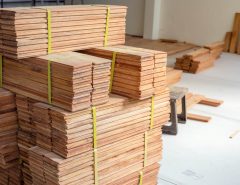It is not all that difficult to install sheet vinyl flooring if you follow these instructions as well as any additional instructions that come with the type of flooring you choose.
Sheet vinyl flooring comes in a single 6′ or 12′ piece, rather than separate tiles or sections. For this reason, it is very important that you measure accurately. This is where a template helps.
1. Assemble your tools. You’ll need the following; however if you don’t already have some of them (such as the adhesive applicator) you may be able to borrow or rent them.
• Hammer, screwdriver, pliers for removing and reattaching doors and baseboards.
• A small saw with a thin blade for “notching” the door trims.
• Tools for removing old flooring, making any necessary repairs, and cleaning flooring. These can include nails or plywood screws, scrapers for removing old adhesive, and industrial-strength cleanser.
• Filler for leveling raised or embossed designs in old flooring if you are not removing it.
• Pencil, heavy paper, straight-edge ruler.
• Utility knife (“box cutter”)
2. Clear the room where the vinyl flooring will be installed. This will make installation much easier.
— If you are installing vinyl in a kitchen or bathroom, you may want to remove toilets and sinks and any appliances that you can. If you don’t feel comfortable doing this yourself, have a professional do this for you.
3. Make a “notch” in the door trim by sawing off a thin strip so that the vinyl will fit snugly against the wall. Remove only enough wood to allow you to slip the vinyl underneath.
4. If you remove old flooring, you will need to make sure all glue, paste, nails, fasteners and other things that held the old flooring down is removed. You will also need to make any repairs to the sub-flooring. As most vinyl flooring can be laid down over existing flooring (except for carpet) you may be able to skip this step.
5. If you decide to leave the existing flooring, you will need to fill in grooves in raised or embossed designs so that the new flooring will be level. If the old flooring or sub-flooring is plywood, you will need to make any necessary repairs as well as fill in nail holes, knotholes, or other places and sand down uneven surfaces.
6. Clean the old flooring or the now-exposed sub-flooring thoroughly, using the industrial-strength cleaner and water. Follow instructions carefully. Let the flooring dry thoroughly.
Now, you’re ready to begin measuring and cutting your sheet vinyl flooring.
7. Use a flooring template or heavy piece of paper to determine the dimensions of the room. Leave a “border” of 1″ to 2″ going up the wall and under appliances or fixtures (if they can’t be removed) so that you will have enough to cut without coming up short. Tape the paper down to the floor so that you will know exactly how your sheet vinyl will fit by cutting small notches in the paper so the tape will adhere to the flooring. Make sure to mark any areas where it may be necessary to fit two separate pieces of sheet vinyl flooring together so that the seams will match up.
8. Unroll the sheet vinyl flooring onto a clean, dry surface, pattern-side down. You may want to do this in a separate room.
9. Turn the vinyl flooring over, and trace your template onto the pattern using a ballpoint pen. Then cut the vinyl, carefully following your template measurements.
— Remember that once the vinyl has been cut, it should be laid down as soon as possible — it can lose its flexibility, becoming harder to handle.
10. Take the cut vinyl into the room where it will be laid, and lay it on the floor, and fold it in half loosely over itself. Apply vinyl adhesive to the half of the flooring that is exposed (not the back of the vinyl itself), let it dry for the recommended time, and glue that half down. Repeat with the other half.
11. Use a rolling pin to remove air bubbles and help the vinyl adhere to the floor better. Smooth as you go, and repeat steps 7 and 8 until all vinyl has been laid.
If it will be necessary to match cut pieces, follow these instructions.
12. Align the seams by overlapping one piece of vinyl over the other by about 2″, making sure the patterns match, and taping them together before you lay down the template. Then follow step 6, making sure your template seams match. After that, use a straight edge ruler to cut off the excess.
13. Follow the remaining steps for installing the tile. When you reach Step 7, work with both pieces of tile, following those instructions, [pictures on page 171 at https://blueglass.box.net/shared/056kqfrnf7] then use seam sealer on the seamed areas.
Allow your flooring plenty of time to “set” before moving appliances, fixtures, furniture and other items back on it. During this time, you may also want to provide additional ventilation to the room to dampen or eliminate the adhesive and new vinyl odor.
Once you are ready to move things back into the room, take care not to cut or otherwise mar your new flooring. You want to be able to enjoy the fruits of your labor for a long time.




















